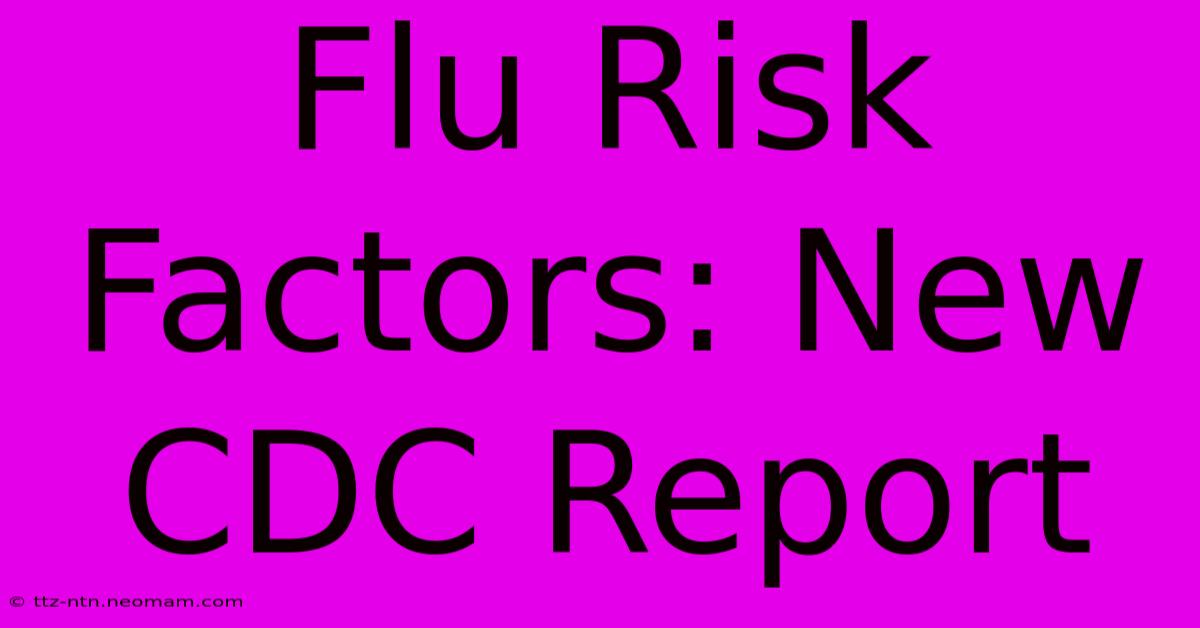Flu Risk Factors: New CDC Report

Discover more detailed and exciting information on our website. Click the link below to start your adventure: Visit Best Website. Don't miss out!
Table of Contents
Unveiling Flu Risk: Key Insights from the Latest CDC Report
Is understanding your flu risk crucial? A definitive yes! The latest CDC report reveals critical factors influencing your susceptibility to influenza, empowering proactive health management.
Editor's Note: This analysis of the CDC's recent flu risk factors report is published today, offering valuable insights for individuals and public health initiatives.**
This topic's importance stems from the annual influenza outbreaks impacting global health. Understanding your risk allows for informed decisions regarding vaccination, preventative measures, and seeking timely medical care. This review summarizes key risk factors, focusing on age, underlying health conditions, and specific populations at higher risk. It also explores the implications of these factors for both individual and community health.
Analysis: This article synthesizes data from the recent CDC report, encompassing epidemiological studies, statistical analyses, and expert commentary to present a clear and accessible understanding of influenza risk factors.
| Key Findings on Flu Risk Factors | Description |
|---|---|
| Age | Infants, young children, and older adults are most vulnerable. |
| Underlying Health Conditions | Chronic illnesses significantly increase susceptibility. |
| Pregnancy | Pregnant women face heightened risk due to physiological changes. |
| Immunocompromised Individuals | Individuals with weakened immune systems are at high risk. |
| Residential Settings | Close-quarters living increases transmission potential. |
| Geographic Location | Flu prevalence varies geographically. |
Flu Risk Factors
Introduction:
This section delves into the key aspects identified by the CDC as significantly impacting influenza risk. These factors are not mutually exclusive and often interact, exacerbating susceptibility.
Key Aspects:
- Age: Infants, young children, and the elderly experience the most severe complications.
- Underlying Health Conditions: Chronic respiratory and cardiac conditions, diabetes, and weakened immune systems heighten risk.
- Pregnancy: Physiological changes during pregnancy increase susceptibility to severe influenza.
- Immunocompromised Status: Individuals with HIV, cancer, or undergoing immunosuppressive therapies are particularly vulnerable.
- Geographic Factors: Flu strains and outbreaks vary regionally, influencing risk levels.
Age as a Predominant Factor
Introduction:
Age significantly correlates with influenza severity and mortality rates. The extremes of age – infancy, childhood, and old age – present the highest risks.
Facets:
- Infants and Young Children: Immature immune systems are less equipped to fight off the virus.
- Older Adults: Age-related declines in immune function and increased prevalence of comorbidities significantly increase vulnerability.
- School-Aged Children: High contact rates in schools facilitate viral spread, impacting the entire population.
Summary:
Age-related vulnerabilities underscore the importance of vaccination campaigns targeting these specific populations to reduce transmission rates and severe complications.
Underlying Health Conditions and Influenza Risk
Introduction:
Pre-existing chronic conditions considerably elevate the risk of severe influenza. This section examines the interplay between these conditions and the severity of influenza.
Further Analysis:
Chronic respiratory conditions (asthma, COPD) compromise lung function, making individuals more susceptible to severe pneumonia, a common complication of influenza. Similarly, cardiovascular disease increases the risk of heart complications, including myocarditis. Diabetes weakens the immune response.
Closing:
Understanding the synergistic effect of underlying health conditions and influenza infection is vital for proactive management. Vaccination, early detection, and aggressive treatment of complications are crucial to improve outcomes.
Frequently Asked Questions (FAQ)
Introduction:
This section addresses common questions regarding influenza risk factors.
Questions:
- Q: What are the most common complications of the flu? A: Pneumonia, bronchitis, ear infections, and sinus infections are among the most common complications.
- Q: How effective is the flu vaccine? A: While not 100% effective, the vaccine significantly reduces the risk of infection and the severity of illness.
- Q: Who should get the flu vaccine? A: The CDC recommends annual influenza vaccination for most individuals over six months of age.
- Q: What are the symptoms of the flu? A: Fever, cough, sore throat, muscle aches, fatigue, and headache are common symptoms.
- Q: When should I seek medical care for the flu? A: Seek medical attention if symptoms worsen, particularly difficulty breathing, chest pain, or sudden dizziness.
- Q: How can I prevent the flu? A: Practice good hygiene, avoid close contact with sick individuals, and get vaccinated.
Tips for Reducing Flu Risk
Introduction:
This section offers practical strategies to mitigate influenza risk.
Tips:
- Annual Vaccination: Get the flu shot annually.
- Hygiene Practices: Frequent handwashing and covering coughs and sneezes are essential.
- Avoid Close Contact: Maintain distance from sick individuals.
- Healthy Lifestyle: A balanced diet, sufficient sleep, and regular exercise boost immunity.
- Stay Home When Sick: Avoid spreading the virus to others.
- Regular Cleaning: Disinfect frequently touched surfaces.
Summary:
Adopting these proactive measures can significantly decrease your susceptibility to influenza.
Conclusion: Understanding and Managing Your Flu Risk
This exploration of flu risk factors, based on the latest CDC report, emphasizes the importance of proactive health management. Recognizing individual risk profiles—considering age, health status, and geographic location—is pivotal in reducing the impact of seasonal influenza outbreaks. The consistent implementation of preventative measures, such as vaccination and practicing good hygiene, is vital not only for personal health but also for community well-being. The continued monitoring of emerging influenza strains and adjustments to vaccination strategies by public health organizations are crucial to effective mitigation strategies.

Thank you for visiting our website wich cover about Flu Risk Factors: New CDC Report. We hope the information provided has been useful to you. Feel free to contact us if you have any questions or need further assistance. See you next time and dont miss to bookmark.
Featured Posts
-
Sigue En Vivo 32avos Mexico Major Padel
Nov 26, 2024
-
Mehl Store Cannabis Saken Utvikler Seg
Nov 26, 2024
-
Defending Champion Game 1 Highlights 2024
Nov 26, 2024
-
Liren Beats Gukesh Chess World Title
Nov 26, 2024
-
Ding Triumphs World Chess Opener Result
Nov 26, 2024
